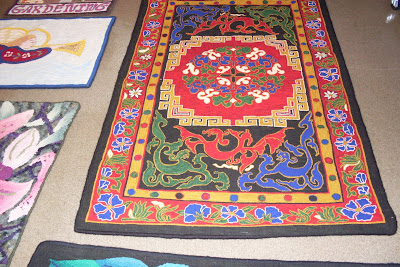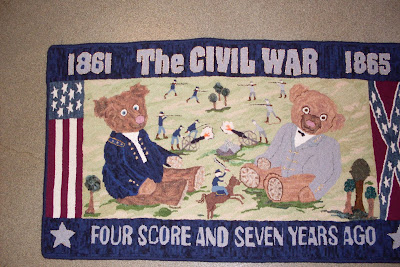The June meeting of this ATHA chapter was held last Tuesday. It is traditionally a pot luck luncheon at which the chapter hosts the Region 3 meeting. All of the chapters in the region are invited to send representatives and generally speaking they have a short meeting with the Region 3 coordinator after the program and luncheon. The Region 3 coordinator was not present this year but 3 or 4 of the chapter representatives attended and we were glad to have them.
In addition, the program was given by Margaret Wenger. Margaret is the chairman of fund raising for the Bicentennial meeting to be held in Lancaster in 2011. However, that was not the prime thrust of the program that she presented to us.
 This is a general view of the group as we listened to Margaret begin to tell us about her use of alternative materials in rug hooking.
This is a general view of the group as we listened to Margaret begin to tell us about her use of alternative materials in rug hooking. Here she is showing us a piece of "flimsy" yard goods that she has hooked with. She showed us velvets, lame', chiffons, laces, and "ribbon yarns" that she has hooked with and many other types of materials, other than wool.
Here she is showing us a piece of "flimsy" yard goods that she has hooked with. She showed us velvets, lame', chiffons, laces, and "ribbon yarns" that she has hooked with and many other types of materials, other than wool. This "flying angle" has very little wool hooked into the piece.
This "flying angle" has very little wool hooked into the piece. This piece was made in a class with Jane Halliwell Green and is wool that has been torn in 1/2 inch pieces.
This piece was made in a class with Jane Halliwell Green and is wool that has been torn in 1/2 inch pieces. Another rug, an oriental, with very little wool involved. I admit that the colors are brilliant and certainly, it does look oriental.
Another rug, an oriental, with very little wool involved. I admit that the colors are brilliant and certainly, it does look oriental. This rug is done with wool and was worked in a Nancy Blood workshop.
This rug is done with wool and was worked in a Nancy Blood workshop. Another rug with very little wool but lots of chiffon and other things.
Another rug with very little wool but lots of chiffon and other things. This rug has been done as a teaching project and represents Grant and Lee and the civil war. Very little, if any wool was used in this rug.
This rug has been done as a teaching project and represents Grant and Lee and the civil war. Very little, if any wool was used in this rug.In all honesty, I came away from this program with many mixed emotions. On the one hand I admire Margaret for her imagination, and her willingness to get out of the box. On the other hand, I am a traditionalist and have the following thoughts about this type of work.
When Margaret was questioned by a member of the audience about the wearablilty of her product???, could these items be put on the floor????, and how could they be cleaned??? She admitted that they could not be put on the floor and that they would not wear well. Also, she had no ideas on how they could be cleaned and kept fresh. My question to myself at that point of the discussion was why call then rugs? That is the reason that I have called them products.
Traditionalist that I am, I want my rugs to be all wool, go on the floor, wear for 100 years and be cleaned and kept fresh. To me, the Old New England Traditional Rug Hooking is an art form of great beauty. I want my rugs to reflect that beauty. I am thrilled when someone looks at my rugs and goes WOW! Somehow or other, alternative materials take the art out of it for me. I'm sure that many of you will disagree with me and I will be very interested in your comments.
I have been hooking since 1970 - I realize that that was before many of you were born. I'm not saying that that makes my rugs any better than anyone else's but I think that it gives me a different take on what is a rug. Barbara was sitting next to me at this meeting. She started hooking in 1968 and her comment was - well, she hooks! I suspect that both of our feelings are a generational thing. Don't hesitate to leave your comments as I will be very interested in knowing how you feel about alternative materials.
Doris
3 comments:
I've only hooked with wool strips and wool yarns... I can't seem to bring myself to hook anything else into a rug. Although... when I put a rug (that I hooked) on the floor... you can bet it's in a low traffic area! LOL!
No matter what the art form you pick, there will always be someone who will put their "spin" on it. Use their imagination to the fullest, step outside the box, etc. I admire it all, even though it may not be my style. Just knowing that they are pleased with what they have created is all that matters. I know some may not like what I hook. That's just fine. They are my rugs. But giving support to the individual is an important reaction in my book. Some are not as confident as others, and any harshness could keep a person from expanding their knowledge of the artform and possibly give up. I would hate to see that happen to anyone who uses their two hands to create something that makes them happy.
As for what is a rug? To "me" the size of the piece determines that. If it's little, it's a mat or a runner. I only call my pieces "rugs" if they are something to be on the floor or large enough to hang on the wall. It's all still hooked in the traditional way, loop by loop! And of course if it is made with something other than wool, then it wouldn't be for the floor. But such large pieces like hers, I would still consider them rugs. Again, just "me".
I agree with you Doris that it could very well be a generational opinion for you. And that is what makes the world go round. There are sooo many opinions :)!
Hope others will give theirs..
Looked like a great time!!
There are a lot of innovative people hooking pieces with non-traditional materials. It's good to push the limits sometimes.
But there is a need to teach the traditional methods of rug hooking also, to keep these techniques alive and well for future generations. Let's not forget the past while striving for new levels of creativity.
You won't be seeing me running chiffon through my beloved Townsend cutter! LOL!!!
Post a Comment